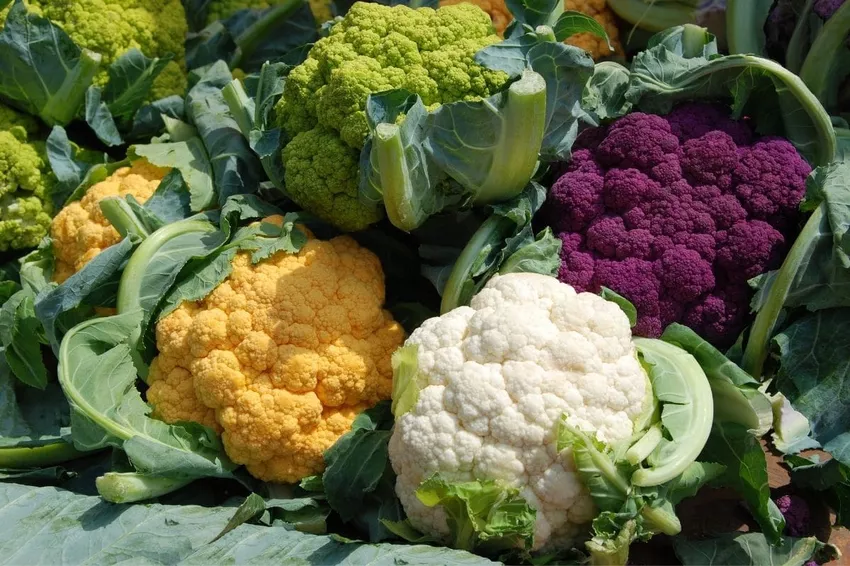- Origin in cabbage
- Colorful diversity
- Regional Preferences
- Health Benefits
- Grow purple cauliflower
- frequently asked Questions

Cauliflower (Brassica oleracea var. botrytis L.) comes in a wide variety of colors. Many hobby gardeners rightly ask themselves whether these varieties really only came about through breeding. However, shades of cauliflower, such as violet or lilac, are natural colors.
In a nutshell
- purple color is a natural coloring
- more healthy ingredients than white breeds
- especially popular in France and Italy
- are rarely available as plants, but are offered as seeds
Origin in cabbage
All types of cabbage are based on the wild cabbage (Brassica oleracea). Through selection based on certain characteristics, these different varieties have crystallized over time. Cauliflower dates back to the 6th century, when seeds from Italy first made their way across the Alps from the Crusades.

Cauliflower is one of the most popular cabbage varieties worldwide. However, the cauliflower is rarely colored. The reason for this is that the white variant was created through breeding, in which colorless plants were deliberately selected. These were more suitable for trade than colored varieties. However, white cauliflower varieties are more difficult to grow than colored ones, as they need more space to form large leaves. The white flower only arises because the leaves largely protect the flower from too much sunlight.
Colorful diversity
There are now numerous cultivated forms of cauliflower, which differ not only in color but also in shape. The Romanesco is also a cauliflower, but it forms pointed mini florets. In addition, Romanesco is usually green, but there are rarely purple varieties.
The cauliflower itself comes in the following colors:
- White
- green
- orange
- purple

However, the disadvantage of colored varieties is that they usually do not retain their color when cooked. In terms of taste, there are no disadvantages due to the loss of color. However, colorful cauliflower varieties are ideal for fresh preparation as a colorful eye-catcher on the plate.
Regional Preferences
While white varieties are popular in German-speaking countries, the situation is different in some countries. Colorful cauliflower varieties are more popular, especially in France and Italy. Purple and green cauliflowers are particularly popular. Romanesco is also more common here than regular cauliflower.
Notice: If you want to grow colored cauliflower yourself, you should look for seeds in stores. Colorful cauliflowers are rarely available as preferred plants in nurseries or garden centers.
Health Benefits
Although white cauliflower is preferred because of its appearance, colored varieties would be much healthier. They contain additional ingredients or the content of ingredients, such as vitamin C, is generally higher than in white varieties.

The high content of dyes in particular is health-promoting, because they are important substances for preventing cancer and can bind free radicals. Here the cauliflower in purple has another weapon against aging caused by free radicals, because sulforaphane can also neutralize free radicals.
Grow purple cauliflower
Colorful cauliflower varieties are more suitable for the autumn/winter harvest and are therefore usually sown later. Depending on the variety, sowing takes place in June or July.
You can grow the cauliflower outdoors or in seed trays. Due to the late cultivation time, the substrate may well be a bit richer. You can mix potting soil with some compost. If you use your own compost soil, you should sterilize it in the oven beforehand.

As soon as the cauliflower plants have formed the first real pair of leaves, they can be separated. The advantage is that you no longer have to prick out the plants, but can place them directly in the bed.
In order for the flowers to be ready in time for autumn, you should pay attention to the following points:
- Row spacing: 60 cm
- Planting distance: 50 cm
- loosen soil
- incorporate nutrient-rich substrate (mature compost, deposited manure)
- water well
Notice: There are so-called self-covering and non-self-covering varieties. In self-covering varieties, the leaves grow over the flower, while in non-self-covering varieties of cauliflower, the leaves must be bent over the flower.
frequently asked Questions
How much water does cauliflower need?Cauliflower generally has a high water requirement. If this is not covered, the flower will be very small or the plants will start to shoot prematurely. Due to the fact that purple cauliflower tends to have an open flower that is not protected by leaves, you should expect several liters per day. The actual amount of water also depends on the type of soil and how well it can store water.
Is purple cauliflower suitable for storage?Purple cauliflower can only be stored for a limited time, as it usually loses its color and turns green in dark storage. However, late cauliflower varieties are an ideal winter vegetable and can also be left outside in winter. If necessary, harvest when it is frost-free.
Can purple cauliflower be frozen?Yes, you can freeze purple cauliflower. However, it also loses its color later when cooking and becomes more greenish.